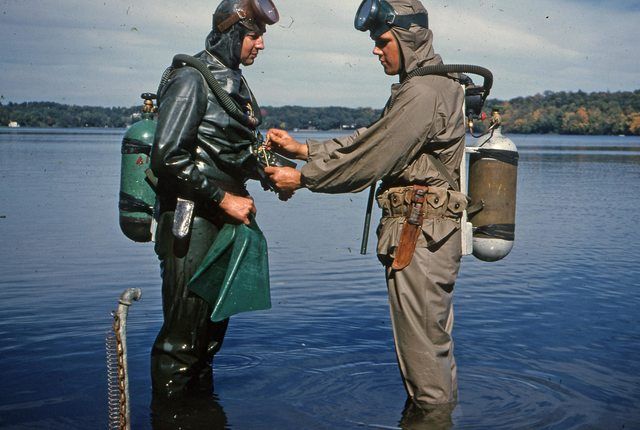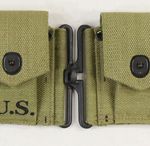|
|
Post by tomcatpc on Nov 5, 2016 20:59:27 GMT -8
|
|
|
|
Post by SeaRat on Nov 5, 2016 22:10:55 GMT -8
Mark,
Diving instructors very early on highly discouraged using cartridge belts as weight belts, as they did not have a one-handed quick release buckle. That made them dangerous in the water.
John
|
|
|
|
Post by nikeajax on Nov 6, 2016 13:10:53 GMT -8
Seven kinds of kool bruddah, thanks fer sharin': I especially liked the Dacor and home-made reg!
DD, you need to see this if you haven't looked at it yet: totally boss!
JB
|
|
Deleted
Deleted Member
Posts: 0
|
Post by Deleted on Nov 6, 2016 13:21:36 GMT -8
Nice find of vintage photos. Had seen images of Robert Travis, just never knew who he was.
|
|
Deleted
Deleted Member
Posts: 0
|
Post by Deleted on Nov 6, 2016 13:48:49 GMT -8
"Flies in the face of quick release." I thought the same thing when we got these in. Because the neoprene puts pressure on the buckle's prong, when you yank on the loose end of the belt, the prong pops out of the way and the belt slides through the buckle. Bingo, one-hand quick release. Free divers like these because the rubber stretches and takes up the slack created by a compressed wetsuit at depth. Good Dives, Charlie I edited my original post after doing some more reading myself. I did in fact experience one of the reasons why the Marseillaise Weight Belt is considered the safest belt. Ascending along a piling I twisted off to one side and triggered my belt. I was 5 feet from the surface so no big deal. My buddy saw the belt zoom by him so he turned around and got it. Anyhow I had never known about the Marseillaise Weight Belt until searching for a supplier for a true round dive mask ealier today. |
|
|
|
Post by SeaRat on Nov 6, 2016 14:12:11 GMT -8
"Flies in the face of quick release." I thought the same thing when we got these in. Because the neoprene puts pressure on the buckle's prong, when you yank on the loose end of the belt, the prong pops out of the way and the belt slides through the buckle. Bingo, one-hand quick release. Free divers like these because the rubber stretches and takes up the slack created by a compressed wetsuit at depth. Good Dives, Charlie Charlie, I was not tslking about the rubber belt with the loaded buckle prong you describe above; I was talking of an Army surplus cartridge belt, and the buckle system is much different. On the Army surplus cartridge belt, there is a small male fitting on one side, and a small female slot on the other. To release this buckle, you need to hold both sides in your hands, twist one side to 90 degrees, and pull it down and away from the female slot which holds it. This is very good for Army infantry, who spend a lot of time crawling on their stomach through who knows what, but very bad for a diver. Mark, I'm sure, understands what I'm talking about, but others who have not been in the military may not. On the cited page, if you scroll down to the last post, the top photo shows two divers in 1950s dry suits, and one has a surplus Army cartridge belt for his weights. John |
|
Deleted
Deleted Member
Posts: 0
|
Post by Deleted on Nov 6, 2016 14:45:17 GMT -8
"Flies in the face of quick release." I thought the same thing when we got these in. Because the neoprene puts pressure on the buckle's prong, when you yank on the loose end of the belt, the prong pops out of the way and the belt slides through the buckle. Bingo, one-hand quick release. Free divers like these because the rubber stretches and takes up the slack created by a compressed wetsuit at depth. Good Dives, Charlie Charlie, I was not tslking about the rubber belt with the loaded buckle prong you describe above; I was talking of an Army surplus cartridge belt, and the buckle system is much different. On the Army surplus cartridge belt, there is a small male fitting on one side, and a small female slot on the other. To release this buckle, you need to hold both sides in your hands, twist one side to 90 degrees, and pull it down and away from the female slot which holds it. This is very good for Army infantry, who spend a lot of time crawling on their stomach through who knows what, but very bad for a diver. Mark, I'm sure, understands what I'm talking about, but others who have not been in the military may not. On the cited page, if you scroll down to the last post, the top photo shows two divers in 1950s dry suits, and one has a surplus Army cartridge belt for his weights. John John, Charlie was not responding to your post, it was mine. I made a post and no more than 60 seconds later found some additional info on my own making the post some what pointless. Anyhow Charlie must have been Johnny on the spot with a reply to mine as it was posted while I was in edit mode. So it's a short story but I can try and make it long and painful. Saw the vintage images link. Loved them. Saw the comment on the ammo pouch weight belt. Triggered a memory from just this morning while searching for a true round mask. Found a Marseilles Rubber Weight with a buckle that looks just like common belt buckle. Not 100% quick release. So with diving instruction pointing out the need to be able to drop weight in an emergency I thought it odd that the overseas free diving community would use such a belt. That was the basics of my now deleted original post. Charlies fast reply was in agreement that the Marseilles Rubber Weight seemed to "Flies in the face of quick release." but they do work and the design is a compromise. There safety point is that the Marseilles Rubber Weight with a roller buckle will not likely have an accidental drop of lead at the cost of a bit more effort to release the belt. |
|
|
|
Post by tomcatpc on Nov 6, 2016 15:39:57 GMT -8
I was joking about using Cartridge Belts as weight belts...
Mark
|
|
|
|
Post by SeaRat on Nov 6, 2016 16:06:42 GMT -8
cstmwrks, I was aware that you guys were talking about those rubber belts, but I'm also very aware that many people can access this site and may not be able to make the distinction. Here's the photo I was talking about:  www.mnscuba.com/forum/showthread.php?tid=6159 www.mnscuba.com/forum/showthread.php?tid=6159Now, to be very clear about why this belt is not appropriate for diving, here's the belt's attachment system (not really a "buckle").  Note that in order to release this belt, you need two hands, and also need to twist the attachment system 90 degrees, and pull it back, to ensure that it is disengaged. This is purposely made to be difficult to unbuckle, as under combat conditions, you really don't want to leave the belt and extra ammo about twenty yards from cover. John |
|
Deleted
Deleted Member
Posts: 0
|
Post by Deleted on Nov 6, 2016 16:13:09 GMT -8
I was joking about using Cartridge Belts as weight belts... Mark Never mind that the belt had a difficult buckle that did not lend to an emergency dump of all ballast, it did allow one to pop a pouch and drop some ballast. Don't know if the thought behind the pouch belt was that dumping all the ballast could almost be as bad or worse than not being able to dump any. I kinda remember some vest type BC's that had some kind of ballast pouches on them. You could shed some weight if deemed needed. Don't know if it was a fad thing or there was always some kind of issue with partial ballast dumping that proved out not worth it. I saw the humor in the comment. |
|
Deleted
Deleted Member
Posts: 0
|
Post by Deleted on Nov 6, 2016 16:27:04 GMT -8
Now, to be very clear about why this belt is not appropriate for diving, here's the belt's attachment system (not really a "buckle").  Note that in order to release this belt, you need two hands, and also need to twist the attachment system 90 degrees, and pull it back, to ensure that it is disengaged. John On the bright side even if some one found this post and was not able to make the distinction that it is not well suited for diving use, finding those belts and pouches at a surplus store now days would be pretty pricey. More costly that just buying a diving belt. Back then lots of dangerous stuff was adapted for use partly because of economics and partly because there was no well developed supply of dive gear back then. |
|
|
|
Post by SeaRat on Nov 6, 2016 16:32:52 GMT -8
|
|
Deleted
Deleted Member
Posts: 0
|
Post by Deleted on Nov 6, 2016 16:50:38 GMT -8
Tell me about it. Way back when I used to have a nice little adapted Cornelius .5 CFM compressor for filling tanks. Bought it for 165.00 back then. Never mind the price now, try and even find one. Sure ebay has then every now and then. Last one I saw like mine was 750.00 and missing parts. Bill |
|
|
|
Post by nikeajax on Nov 6, 2016 17:03:49 GMT -8
 I loved this image: everything about it! I'd totally love to show up somewhere and dive this kit, as-is, just to see the look on a modern divers face: those bike tube straps would send a dive master into instant cardiac arrest, "Quick, someone get the defib..."  After I was done I'd tell the DM, "Oh, don't worry, I have newer gear; I've got a Divair!"  On closer inspection: are those backpacks made from wood?  SWEEEEET! JB |
|
|
|
Post by nikeajax on Nov 6, 2016 17:08:42 GMT -8
Now, to be very clear about why this belt is not appropriate for diving, here's the belt's attachment system (not really a "buckle").  Note that in order to release this belt, you need two hands, and also need to twist the attachment system 90 degrees, and pull it back, to ensure that it is disengaged. John On the bright side even if some one found this post and was not able to make the distinction that it is not well suited for diving use, finding those belts and pouches at a surplus store now days would be pretty pricey. More costly that just buying a diving belt. Back then lots of dangerous stuff was adapted for use partly because of economics and partly because there was no well developed supply of dive gear back then. I've got one that belonged to my father in law, WW-II vintage, kinda tempted to thread it through some weights and take a picture just o be a brat  or not... JB |
|